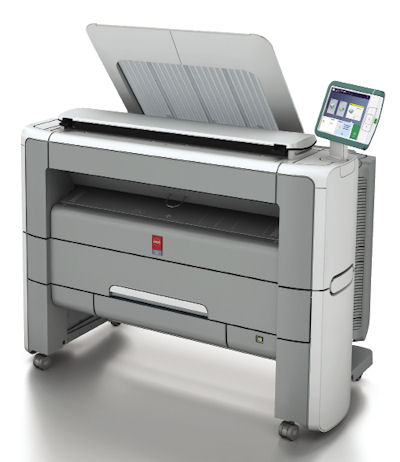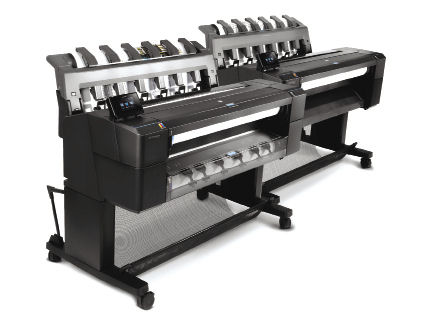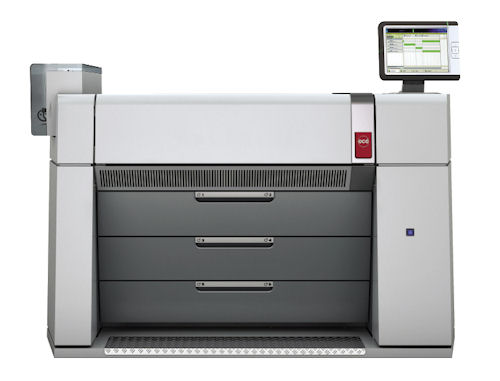Printers take on Collaboration
Large-format printers and scanners embrace the cloud to send prints and scans anywhere.
Latest News
September 1, 2013
 Canon Solutions America’s Océ PlotWave 340 and Océ PlotWave 360 (pictured) large-format monochrome printing systems feature 10.4-in. multi-touch panels that allow users to control the printer via tablet-like gestures. |
Those two factors—collaboration and smaller form factors—are enabling new workflow possibilities for engineers. But as fast as technology changes, it can be difficult for company cultures to catch up. Take printing from the cloud, for instance.
“No question: Cloud-enabled workflows are ahead of the curve,” says Bob Honn, director of product marketing for Canon Solutions America, which recently introduced its new Océ PlotWave 340 and Océ PlotWave 360 large-format monochrome printing systems that have cloud-based features. “Users are still catching up. It still remains to be seen how much they’re going to adapt to it.
“How many people do you see working with iPads and other tablets?” Honn asks. “Those are the ones catching up with the curve. We’ve got the tools, and we’re making it accessible and available so we can see where it goes.”
Canon is not the only large-format printer/scanner company embracing a collaboration strategy. Epson released three printers in its SureColor T Series late last year, which are designed to work with leading cloud-based services. The latest Contex IQ 4400 scanner series makes use of the company’s PageDrop technology, which allows you to scan and send documents via email, cloud services like Dropbox and Google Drive, or any HP ePrint-enabled printer. Speaking of HP ePrint, this summer, the company released its HP Designjet T920 and T1500 ePrinter series, which are designed to help users access, view and print projects from the cloud.
“We have mobile tools to collaborate across the globe,” says Alex Monino, strategic marketing manager for HP’s Designjet Business, “but printing up until now has been local.”
Integrating the cloud into an engineering workflow is changing all that.
“There is still a need for the prints, but the point of need has changed,” says Andrew Vecci, director of business development at Canon Solutions America. “Instead of mailing prints to a site, people are receiving files digitally and need to print them. They’re moving away from dedicated print operators, so we need to accommodate untrained walk-up users and build printers that are easy to operate.”
Mobile Matters
Mobile computing has not only influenced printer manufacturers to provide cloud-based printing and apps that allow users to control printers and scanners on the go, it has also changed the way walk-up users interact with their products. Every major printer/scanner manufacturer has incorporated some type of touchscreen, because non-expert users can walk up to the printer and be guided through various functions by on-screen prompts.
 HP has introduced two web-connected printers, the Designjet T920 and T1500 ePrinter series, which feature a new ergonomic design. |
For example, Canon’s Océ PlotWave 340 and Océ PlotWave 360 printing systems’ 10.4-in. multi-touch screen also provides a means to present a print preview, which Vecci notes is handy when you have multiple users sending jobs to the printer. It can also be used to navigate through an inbox of prints a user sent to the printer and scroll through thumbnails to choose a print job.
The HP Designjet T920 and T1500 ePrinters include HP Designjet ePrint and Share, a free Web service that allows users to save copies of projects to the cloud when printing. Users also can email projects to print by attaching a PDF or other print-ready file to an ePrinter’s dedicated address.
“I keep hearing about our customers using tablets and going fully digital,” says Monino. “But when we talk to customers, we discover some can do their work digitally, but there’s so much pan and zoom it’s not efficient. They want the ability to collaborate on paper, and then bring that design back into digital world.”
Proper Paper Handling
Today’s large-format printers are small enough to be pushed against a wall to save space in any office. They are also designed to avoid downtime by making paper handling and refills more efficient.
| Océ ColorWave 900 Launching in U.S. Canon U.S.A., Inc. is launching the Océ ColorWave 900 printer at the PRINT 13 show in Chicago this month. The company says it closes the gap between digital inkjet and traditional offset technology. It is designed to increase productivity, lower running costs and increase flexibility for variable data and short- to medium-run length print jobs. “We see the Océ ColorWave 900 printer as a disruptive technology because of its ability to provide a cost-effective and efficient alternative for producing short-run jobs,” said Junichi Yoshitake, senior vice president, Business Imaging Solutions Group, Canon U.S.A. in a press release. “Using this technology, shorter print runs can now be more economical by eliminating plate making and make-ready, while still maintaining the high image quality that our customers expect.” According to the company, the Océ ColorWave 900 printer has a print speed of more than 12,000-sq.-ft. per hour. It is capable of resolutions of 1,600 x 1,600 dpi, and has a maximum media width of 42 in.
|
The HP Designjet T920 and T1500 ePrinters have an integrated output stacking tray that is built in on top of the device to deliver flat, collated prints. Built for against-the-wall operation, the front-roll loading feature allows users to load media easily, even while seated, according to the company.
Canon’s new Océ PlotWave systems have an integrated top delivery tray that uses Oce’s air delivery system to keep documents stacked and collated, according to the company.
Epson’s SureColor T-Series uses a spindle rod that makes it easy to slide media rolls into the printer, says Tim Check, product manager of Epson America’s Professional Imaging Group. The series also has a passive stacking system that uses a set of bars inside the print basket. “As it continues to print, the paper goes over the top of basket and folds over the bars,” Check says. “A guide keeps the paper stacked atop each other.”
All of these large-format printer manufacturers are trying to make it easier for small- and mid-sized businesses, or even engineering departments within large enterprises, to purchase, use and maintain their own large-format printer. While engineers continue to evolve into a digital workflow, the large-format printer’s place in that workflow is not going away.
“Printing digital files at point of need is where it’s moving,” says Canon Solutions America’s Honn. “It’s the biggest segment of the market, and the one to which we continue to sell the largest number of devices.”
Jamie J. Gooch is managing editor of DE. Send e-mail about this article to [email protected].
More Info
| Large-Format Printers at a Glance | ||||
| Large-Format Printer | Speeds) | Dimensions (WxDxH) | Media | Of Note |
| Canon Solutions America Océ PlotWave 340/360 printing system | Océ PlotWave 340: 4ppm (D-size/A1); Océ PlotWave 360: 6ppm (D-size/A1) | 60.6 — 31.5 — 58.9 in., including top delivery tray | 1-2 rolls from 11 to 36 in. wide | Less than 1 second warm-up time |
| Epson SureColor T-Series | 25 seconds per D-sized plot in fastest mode | 41.3 to 63.3 x 32 x 44.4 in., depending on model | Cut sheets up to 44 in. wide or 1 roll from 24 to 44 in. wide, depending on model | Resolution up to 2880 x 1440 dpi |
| HP Designjet T920 and T1500 | 21 seconds per D-sized print in fastest mode | 55.1 x 36.1 x 43.7 in. | 8.3- to 36-in. wide sheets, or 1 to 2 rolls from 11 to 36 in. wide | Integrated output stacking tray for flat, collated prints |
Subscribe to our FREE magazine, FREE email newsletters or both!
Latest News
About the Author
Jamie Gooch is the former editorial director of Digital Engineering.
Follow DE





